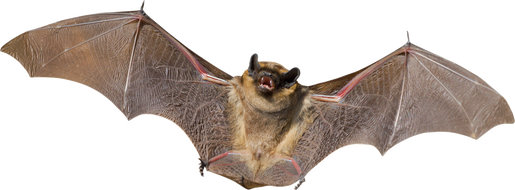BatsSince bats live in houses, they are often considered a pest species. These are the most common complaints:
BAT BIOLOGY North America is home many species of bats. However, these three are the most common (and annoying) in the US. The Little Brown Bat (Myotis Lucifugus) is the first, and is very common in most of the US. They are small and weigh less than half an inch. Large maternity colonies are formed by females, which often live in barns or attics. The young are born in June, and they can fly as early as August. Although they can live for up to 30 years, their average lifespan in the wild is about 7 years. They hibernate during winter. In the northern regions, they are also known as the Big Brown Bat . The species can grow up to 13 inches in wingspan and live up to 19 years wild. They mate in October before winter hibernation. After a delayed fertilization and 60-day gestation, they give birth to one or more baby bats in June. The Mexican Freetail Bat Tadarida brassiliensis is a common species in the south. It can live up 16 years with a wingspan of 8 inches and a weight of just half an ounce. These bats can form large colonies with up to several hundred thousand members. They mate in autumn, but they delay fertilization. One pup is born in June and can fly around eight weeks later. These bats love to roost in attics and man-made structures. Although none of these bats are blind, they use echolocation to help navigate on the wings. All of them are insectivorous and catch insects on their wings. BAT BEHAVIOR Bats have a nocturnal behavior. They spend the day in their roosts and then emerge at night. If there is a colony of bats in a building they will crawl to the edge and fly out. They first head for water, then get a drink and skim the surface of the wings. Then they eat flying insects, primarily beetles and moths. They eventually get tired and return to their nest to rest. They fly back to the nest to eat more. They might make multiple trips each night. Echolocation is used by bats to help them navigate and feed on their wings. They make high-pitched chirps, and they can read the sonar-like sound waves that bounce back from objects. The species and gender of bats that you are interested in colonizing will determine your roosting preference. However, we only care about the three above mentioned bat species. These colonies are dominated by females. Males prefer to roost in isolated areas such as trees. Females often form large groups in man-made structures like bridges, attics and church towers. They can tolerate, and even like high temperatures. As the climate changes, many southern bats move to new areas. The north hibernates in colder temperatures, however. NUISANCE CONCERNS The primary concern is large colonies. It may not seem like a major problem if there are only a few bats. If you have a large maternity colony, however, it could be a problem. Large colonies can be noisy at night and disturb your sleep. They also leave behind their urine and droppings. This can really add up if there is a large number of bats. After a while, large amounts of droppings begin to form. The urine and droppings can corrode metal or wood, and the weight of the waste can cause the ceiling to collapse. I have seen it happen quite a few times. It can have a strong odor and can grow fungal spores, which can lead to Histoplasmosis, a lung disease. BAT DISEASES Histoplasmosis, which is a fungal infection in the lungs caused by the fungus found in nitrogen-rich bat droppings. However, it's important to remember that the majority of cases of rabies transmission in America have been from bats. People are more cautious around bats than rabid rats, and bats can bite people while they sleep. This could explain why the infection rate is higher. Perhaps it is because bats and certain bat species carry a strain of rabies which is more likely to infect humans. However, you should not pick up a sick bat that is lying on the ground. You might be bitten. WHAT CAN I DO TO GET RID of BATS? Bat removal is not an easy task. It is not possible to use a bat repellent that works quickly. You can eliminate the colonies by sealing off all secondary entry points and safely removing all bats from the structure. It can be very difficult and must be done correctly. A novice attempt by someone without experience or worse, a pest company using bat poison could lead to disaster. Bats will swarm throughout your home and walls. You can get rid of bats from a building by reading the articles. They describe how to seal all entry points, place one-way exclusion devices on primary and secondary bat exit holes, and clean up the mess. CAN I USE A REPELLENT ALONE? There is no effective or registered bat repellent. There are many bat-repellent and bat-away products that can be sold by companies, but these are all bogus. What about those high-pitched noisemakers? They are not effective, according to the FTC. Bat control is not a quick fix. A professional with many years of experience is the best person to solve the problem. |
|


